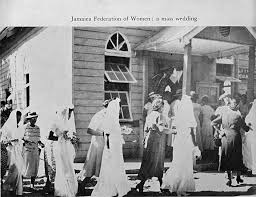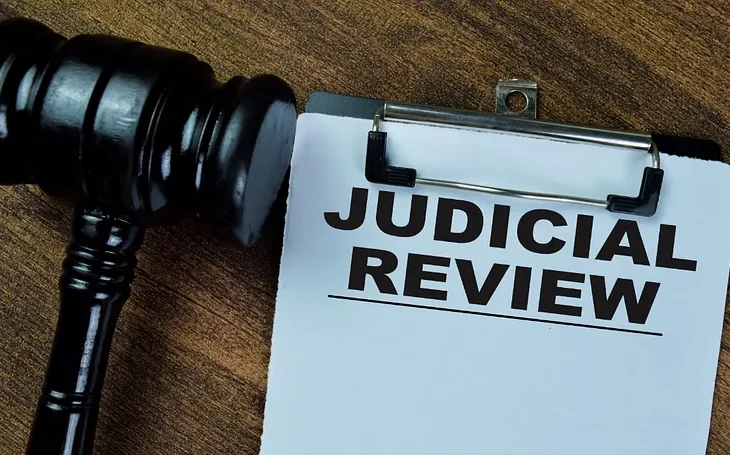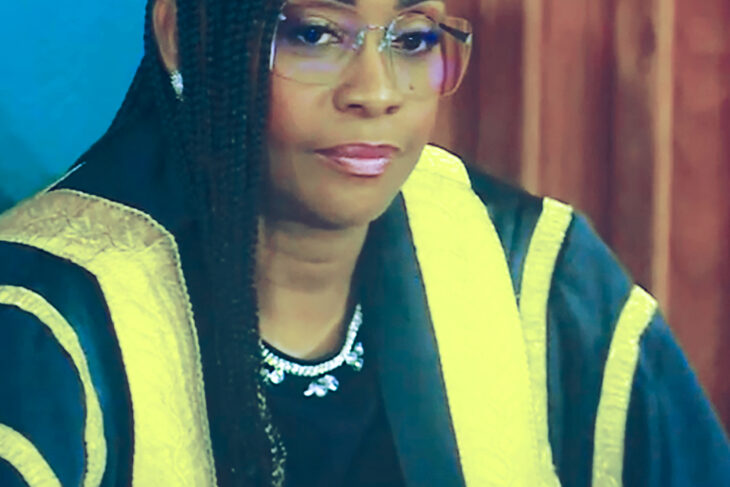

In the 1940s and 1950s mass weddings constituted a campaign to reduce high rates of illegitimacy and were spectacular public rites of accessing citizenship. These weddings were attended by prominent public officials, social workers and members of the community.
In a 1941 wedding in Kingston, 36 couples were married at the City Mission Church. The event took place in two ceremonies in order to accommodate the large numbers, and the officiating clergy came from several denominations. Spectators gathered early to watch but only those with invitation cards were allowed inside. These invitations could be purchased at a small cost to defray the expenses of the public weddings.
The Women’s Liberal Club (WLC) provided gowns and rings, and paid for the celebrations. The brides were led down the aisle by a member of the club who, as their sponsor, gave them away in marriage. The men were escorted by Jim Russell, the Civil Registrar of births, deaths, and marriages, and a central figure in the movement. He boasted that mass weddings had significantly reduced illegitimacy in Jamaica.
By the mid-1950s, however, the numbers of couples who could be encouraged to undergo these ceremonies had dwindled, as had the public interest. In addition to promoting marriage, the Jamaica Federation of Women (JFW) began promoting the registration of fathers on a child’s birth certificate, and was one of several groups that waged campaigns against bachelor fatherhood. This led Louise Bennett to write the poem Registration, some lines of which follow:
For it eena newspapa
Sey ooman Federation
Dah-pass law fe all fada name
Go dung pon registration!
Mary Morris Knibb, an educator, benefactor, social worker, teacher, and pioneer, played a leading role in the popularisation of mass weddings.
Born in 1881, Morris Knibb was a foundation member of the JFW which was one of the foundations of the emerging middle class. The JFW was really a social welfare organisation founded by Lady Allan, Lilly Mae Burke, Morris Knibb and other Jamaican women. It was supported energetically by Molly Huggins, wife of the Governor, Sir John Huggins. Soon, almost every senior female teacher and principal became a member, evidence of which was a round button they wore with the words Jamaica Federation of Women encircling a map of Jamaica.
Many men and women had been living together in homes and were bringing up families but had not entered into marriage. Mary Morris Knibb took note of that and started the idea of mass weddings. Lady Huggins, having attended a mass wedding soon after her arrival in December 1943, endorsed Morris-Knibb’s initiative and assumed the position of a spokesperson. By 1944 there was a mass wedding committee in place which Lady Huggins chaired as president and patron. She once brought back 900 gold rings for mass weddings from a women’s conference in the United States. By the end of the 1940s, the JFW had taken over the organisation of most of the mass weddings.
The mass weddings caught on and Mary Morris Knibb took up the cause with zeal. While the idea of the JFW was to provide a social outlet for women and to organise them as a social force in a country where they had no real voice, the mass weddings of Miss Married Knibb, as Louise Bennett dubbed her, was the method by which she tried to replace illegitimacy and concubinage with marriage.
In mass weddings the gold wedding rings were made available free by the JFW, and several couples were married at the same place and time to reduce expense. City Mission Bishop Mary Louise Coore, who was one of the earliest ordained female ministers in Jamaica and — it appears — the island’s first female marriage officer, and Bishop Delrose Lucille Walters joined forces with the JFW in organising mass weddings in Kingston’s inner cities.
The first mass marriage recorded was held at the City Mission in July 1939. Many of these ceremonies were held at the headquarters of the City Mission churches at 15 Blount Street in Hannah Town, West Kingston. In Montego Bay, 41 couples were married, kick-starting JFW’s home-building concept. The popularity of these weddings gained even more support when Louise Bennett promoted them in her poem Mass Wedding, excerpts of which follow:
Me meet one boonoonoonos man
At Matches Stick last night
As me clap me y’eye upon de chile
Me head begin get light.
De ongle time him look pon me
Me heart dis go buff-bim
Him nice an ‘tall soh tell ah hooda
Go into jail fe him.
Me want go fine out wey him live,
So afta pickcha dun,
Me meck afta him, but crowd so tick,
Me noh see weh him tun.
Soh me goin’ to de lady name
Miss Married Knibbs to see
Ef she can fine him an fix up
One mass wedden fe me.
Morris Knibb rose to become the first elected woman representative of the Moravian Church in Jamaica and the first female councillor of the Kingston and St Andrew Corporation (KSAC). It was March 8, 1939 that she won the by-election for a seat in the KSAC, taking 1,231 votes, which was double the votes of both her rivals combined — an accomplishment attributed to her record of civic leadership and commitment to excellence.
That record was established on two strong foundations, a preparatory school which bore her name and prepared students for high school, and her membership and leadership of two social organisations — The WLC and the Jamaica Federation of Women which exerted lasting impact on the country at large. She played leading roles in both. But first, the preparatory school.
Morris Knibb established the school at 5 Hector Street in 1928. At the time the gateway into secondary education for elementary school children was extremely narrow, and parents who wanted their children to have a good chance of getting into one of the existing high schools were prepared to extend themselves and pay for that chance. With smaller classes and devoted teachers, the preparatory schools began opening the gates a little wider. Morris Knibb’s school was one of the earliest of its kind, and one of the best, and many still sing their pleasure at their experience there. Among its most famous students are noted surgeon John Hall and singer Harry Belafonte.
The WLC was established in 1936 and it comprised middle-class Black women, many of whom were teachers. The organisation devoted itself to the social upliftment of poor Black women, advocated strengthened participation of women in politics, and attempted to foster racial pride and national spirit. As President of the WLC — which comprised outstanding women, including Edith Clarke, Amy Bailey and Lady Huggins — Mary Morris Knibb organised a Deaconess fund for the Moravian church, which was designed to promote leadership among girls. Her leadership aspirations propelled her to become the co-founder and vice-president of the Moravian Women’s Fellowship, and founder of the Shortwood Teacher’s College Alumni Association.
A champion of women’s rights, Mary Morris Knibb was an active part of the National Movement’s promotion of suffrage since she was at the forefront of women’s struggle for the right to vote. However, while her greatest achievement was as the founder and manager of the preparatory school, her other great passion was her role in the assault on common-law relationships through mass weddings which were promoted by the JFW.
Mary Morris Knibb died on September 21, 1964 at her home in Woodford Park, St Andrew, at the age of 83. She was honoured when the church hall at the Redeemer Moravian Church was named after her. The church hall and the Extension College on the grounds of the preparatory school are seen as edifices to her philosophy of self-reliance and development. The headquarters site and building adjacent to the preparatory school were bequeathed to the Moravian Church by her.
As part of its 250th anniversary year celebrations in collaboration with the Postal Corporation of Jamaica, the Church launched a commemorative stamp series to honour her and two other of its stalwarts.
(Wedding picture from the archives of the National Library of Jamaica)



